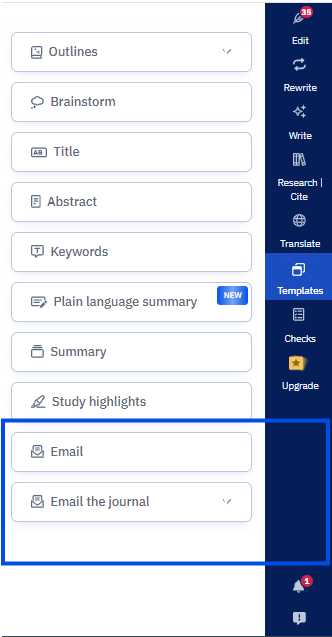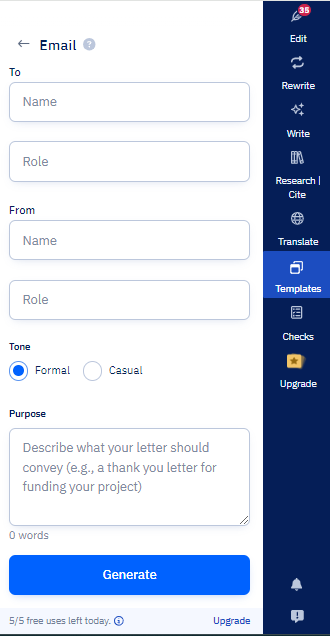Table of Contents
The publishing process can be lengthy, and research authors are often unsure about how to ask a journal editor about the manuscript status. After spending long hours on their research, writing their manuscript, and preparing for journal submission, most authors are hoping for a quick response. While many journals have a submissions platform that displays the status of manuscripts, it is not uncommon for these to remain unchanged for an extended period of time. This makes it necessary to write to the journal editor for updates. However, most researchers, especially students and early career researchers, are unsure when follow-ups should be initiated and the best way to do so. This article aims to guide researchers by sharing writing etiquettes and best practices when writing to editors to ask about manuscript status.
Write a gist and let Paperpal craft your email in minutes
Understanding the ideal journal wait time
Many research authors are unsure not only about how to ask journal editors about their manuscript status, but also when to reach out to the editor is equally important. Before contacting the journal editor, it is important to consider an appropriate wait time.
Different journals have their own guidelines regarding submissions and turn-around times to inform authors of the manuscript status. This again depends on the topic or field related to which the manuscript has been written, so be sure to know this for your target journal. Depending on the journal’s guidelines and typical review timelines, a wait time of 8-10 weeks is often considered reasonable after which authors can inquire about the manuscript status.
Generally, once an article or manuscript submission has been made, its status can be monitored online. Authors are usually able to check the status of their submission via a journal’s “article submission” link on the journal’s website. Additionally, a sub-link to “e-mail” and correspond with the editors or designated contact persons of the journal may also be provided. However, there are occasions when the submission status remains unchanged for long periods of time. This wait for an update can be nerve wracking and the best way forward would be to write to the journal editor to ask about the manuscript status.
Key elements: Writing to editor to ask about manuscript status
When drafting an inquiry about manuscript status, make sure to include the following essential points in your email:
- Introduction: Greet the journal editor and express hope that they are well.
- Manuscript details: Clearly mention the manuscript title, date of submission, and, if available, the manuscript ID.
- Acknowledgment: Show appreciation for the time and effort invested by the editorial team and reviewers in evaluating manuscripts.
- Request a status update: Politely inquire about the current status of your manuscript and express your concern about the lack of updates.
- Additional information: Offer any additional materials or information that may assist the review process, if applicable.
- Closing: Thank the editor for their time and consideration, express your anticipation of their response, and provide your contact information.
Customize your email with Paperpal’s simple templates > Try it now!
How to write an email to journal editor sample
When writing an email to the journal editor, it is essential to be respectful, concise, and professional. Most importantly, maintain a tone of patience and politeness. Remember that your manuscript is probably one of the many others that the editor may be sifting through and evaluating. Here is a sample email template that you can use as a guide:
Subject: Inquiry About Manuscript Status – [your manuscript title]
Dear [Editor’s Name],
I hope this email finds you well. I am writing to inquire about the status of my manuscript titled “[your manuscript title],” which I submitted to [journal name] on [submission date]. I understand that the publishing process requires careful consideration and often takes time. However, the status of my manuscript has remained unchanged on the submissions platform for an extended period.
I appreciate the efforts of the editorial team and reviewers in evaluating manuscripts, and I understand the workload involved in managing the publication process. I wanted to inquire if there are any updates regarding the review or decision for my manuscript.
I understand that you receive numerous inquiries on manuscript status. To facilitate a prompt response, I have included the relevant details below:
Manuscript Title: [Your Manuscript Title]
Manuscript ID: [If available, provide the manuscript ID]
Corresponding Author: [Your Name]
Submission Date: [Date of submission]
If possible, could you please provide an estimated timeline for the next steps or any information regarding the review process? I would be grateful for any updates that can be shared.
Thank you for your time and consideration. I look forward to hearing from you soon. If there is any additional information or materials I can provide to assist in the review process, please do not hesitate to let me know.
Sincerely,
[Your Name]
[Your Affiliation]
[Your Contact Information]
Inquiring about your manuscript status is a reasonable and important step in the publishing process. If there is no reply to your inquiry (which is rare), you can send a follow-up email politely reiterating your inquiry about manuscript status. Be careful to avoid bombarding the editor with multiple emails in quick succession though.
If there is a reply indicating a longer waiting period, then you may decide to withdraw the submitted manuscript after providing a valid reason for the action. However, withdrawal of a manuscript submission is not recommended as you will have to undergo the same process once again with a different journal or publication.
How to write an email to the journal editor with Paperpal?
Now make writing your manuscript-related emails a breeze with Paperpal. Use Paperpal’s Generative AI features to generate structured emails that convey your message convincingly and effectively to journal editors. Here’s a walkthrough:
- Go to Paperpal Templates > Email
- Share a gist of what you want to write
We know that generic emails won’t make the cut, which is why Paperpal offers 5 tailored templates for different scenarios:
- Cover letter for journal submission
- Inquiry on manuscript status
- Deadline extension for submitting revised manuscript
- Submitting a revised manuscript as a new submission
- Withdrawing the manuscript from a journal
Generate Emails Effortlessly
Say goodbye to manual email crafting. Here’s a quick step-by-step process to generate emails efficiently with Paperpal.
- Keep all the details handy: Ensure you have all the information you need to include before you start.
- Generate your email: Choose your email template and fill in all the key details, such as manuscript title, editor name, journal name, and important data to include.
- Double-check generated text: Once the AI generates the letter, check and refine to ensure all the relevant details are included.
- Refine the language: Do a final proofreading to polish the letter, and make sure the tone is personal and professional. You can use Paperpal’s in-depth grammar checks to do this.
Let Paperpal handle the intricacies of email writing. Click here to start now!
By following the guidelines outlined above and using the provided email template, you will know how to write to journal editors for manuscript status updates. Be sure to refer to the specific journal’s guidelines and policies when inquiring about manuscript status, as they may have their own preferred mode of communication. Finally, remember you can save time and communicate effectively with journals with Paperpal, which is designed to support academics on the writing and publication journey. Sign up to Paperpal now and try this for yourself!
Paperpal is a comprehensive AI writing toolkit that helps students and researchers achieve 2x the writing in half the time. It leverages 21+ years of STM experience and insights from millions of research articles to provide in-depth academic writing, language editing, and submission readiness support to help you write better, faster.
Get accurate academic translations, rewriting support, grammar checks, vocabulary suggestions, and generative AI assistance that delivers human precision at machine speed. Try for free or upgrade to Paperpal Prime starting at US$19 a month to access premium features, including consistency, plagiarism, and 30+ submission readiness checks to help you succeed.
Experience the future of academic writing – Sign up to Paperpal and start writing for free!





